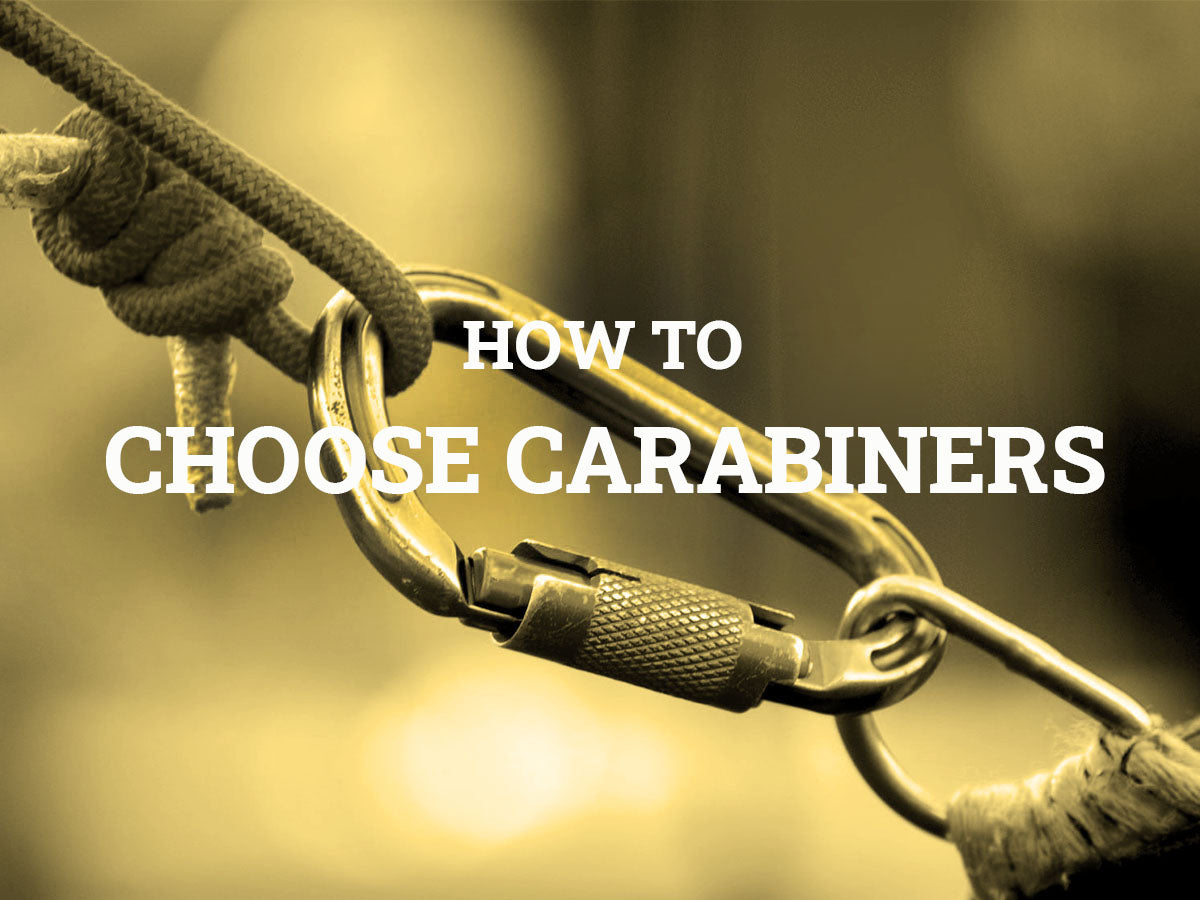How to Choose Carabiners

Carabiners are an important piece of climbing equipment. They are small metal loops with a spring-loaded gate. There is a wide variety of uses for carabiners, and the type will determine the use it is best fit for. Lets take a look at the styles, but first some basics. Read on and learn how to choose carabiners.
Common Terminology

Gate – The spring-loaded side of the carabiner that opens, allowing you to connect to gear.
Spine – The side opposite the gate. This is where most of the force and weight is carried.
Gate Opening – How wide are you able to open the gate of the carabiner. The width of opening is determined by the size and shape of the carabiner.
Nose – Where the gate meets the solid part of the carabiner.
Materials
Steel – Steel carabiners are most often utilized in rescue and industrial rigging scenarios, because of larger forces and working loads. Steel carabiners are stronger, more durable, but also much heavier than Aluminum carabiners.
Aluminum – Aluminum carabiners are lighter than steel and designed specifically for recreational climbing where the forces and working loads are much less.

Shape
Oval - The classic oval carabiner has been around for decades, and still has an important place. The symmetrical oval shape allows them to be flipped or rotated easily, they also racks consistently, and are inexpensive. Oval carabiners are great for aid-climbing, as they don’t interfere with other carabiners clipped to them. However, oval carabiners are inherently weaker than other shapes (transferring weight equally between the spine and the gate), have narrower gate openings, and are fairly heavy. In situations where lighter weight and strength take precedence (i.e. most of the time), D-shaped carabiners are a better choice.
D-Shape - Designed with an asymmetrical shape, D-shaped carabiners transfer more force away from the gate towards the spine of the carabiner, and are therefore the strongest. Because of this design, D-shaped carabiners can be made lighter than others and have a wider gate opening. For clipping into protection, use in quickdraws, and for locking anchor points, D-shaped carabiners excel. Since they are more versatile than a standard symmetrical oval shape, they are also more expensive.

Offset D-Shape – Very similar in design and function as a D-Shape carabiner. The only main difference is an exaggerated asymmetrical design, allowing for an even wider gate opening. These are slightly more expensive than a standard D-Shape carabiner.
HMS Carabiner – Also referred to as pear-shaped carabiners, these are special oversized versions of the offset d-shape designed for belay use. Because of this design, they excel when used with a belay device or using a hitch to belay with. HMS carabiners suffer the same weight and strength drawbacks of oval carabiners, and are often made out of a thicker bar-stock to compensate. Still, they tend to be very easy on your rope, and many climbers prefer HMS carabiners to connect to their belay device.
Shop all GearX's carabiners.Gate Mechanisms
Non-locking
Straight Gate – The straight gate is the most common and versatile type of opening system. They feature a straight piece of solid aluminum or steel, and as the name implies, the gate is perfectly straight form the hinge to the closure point.

Bent Gate – The bent gate design feature a slight curvature in the gate. With the same spring-loaded design, the bow shape of the gate makes clipping in and out of gear easier. Designed specifically for use on quickdraws, a bent gate carabiner should never be used to clip in directly to protective gear. Improper use of a bent gate carabiner can result in accidental unclipping and put a climber at serious risk.
Wire gate – The primary difference is the use of a narrow loop of wire for the gate. The narrow loop design cuts down on weight without sacrificing any strength or durability. A wire gate carabiner can come in either a straight or bent gate design. The biggest advantage to wire gate carabiners they hold up better to corrosion, snow, and icing-over better than a solid gate carabiner.
Shop GearX's selection of non-locking carabiners.Locking
Locking carabiners have a similar design and function to non-locking carabiners with the only noticeable difference being an additional sleeve on the gate used to secure it to the nose. This addition creates more security and peace of mind in regards to the carabiner opening when it shouldn’t. They are more expensive and heavy in comparison to non-locking designs.

Twist Lock – The twist lock carabiner has a spring-loaded sleeve that must be turned in order to release the gate from the nose. They automatically lock shut with the spring-loaded design. This design is susceptible to wear and tear on the spring, dirt, ice, and other mechanical issues.
Screw Lock – The screw lock features a threaded sleeve that must be manually screwed open or closed in order to release the gate. They are less vulnerable to component malfunction because they have fewer moving parts than a twist lock carabiner.
Shop GearX's selection of locking carabiners.